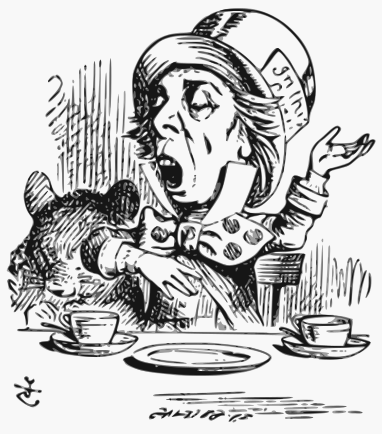Here’s a random bit of trivia for you to pull out at your next Mad Men cocktail party…
 |
| The Mad Hatter, illustration by John Tenniel , 1865 |
Where Does the Phrase “Mad as a Hatter,” or “Mad Hatter” come from?
Today we are most familiar with “The Mad Hatter” from Lewis Carroll’s famous “Alice in Wonderland,” but the saying goes back further than Carroll’s 1865 publication, and potentially had nothing at all to do with the crafters of fine headwear.
The common belief is that the name “Mad Hatter” references the fate of hatmakers who suffered from consistent inhalation of mercury, a chemical commonly used in the curing of hat felts. The long term effects of breathing mercury everyday included uncontrollable twitching, trembling, and demented behavior. It makes perfect sense to us today, when we imagine the illustrative renditions of Carroll’s famous character.
 |
| The Depp-Burton version of the character, entirely obnoxious, but creative. For the record, his hat is really quite spectacular, though doesn’t appear to be made of fur felt… |
However, the phrase “Mad as a Hatter” was not invented by Carroll, and was in use in literature as far back as 1829. Even prior, the phrase was in common use in England and is very possibly an evolution of a phrase of an entirely different meaning, “mad as an atter,” with the meaning “as venomous as a snake,” rather than as kooky as a hat maker, “atter being the original Anglo-Saxon form of “adder,” and “mad” being synonymous with “venomous,” as well as crazy and angry.
.png) |
| I bite you! |
Of course, mercury-poisoned hatters makes for a far more interesting story, and is not at all untrue. Vaporized mercury was indeed used to remove the fur used in fur felt hats, such as beaver hats, from the pelts, to then matt into the felts. Steaming and ironing fur felts into shape kept all that mercury in the air, and on the skin, and lead to all kinds of horrible side effects.
 |
| A beaver felt hat, all the rage for particularly men’s headwear in the 19th and early 20th c. |
So there you have it. Amaze your friends and impress your boss over the miniature franks and martini olives. 🙂


8 Comments
Linda M McCarthy
March 15, 2012 at 9:14 PMHI. The costume and hat designer for the Depp-Burton version is Colleen Atwood.
Phoebe's Sisters
March 15, 2012 at 9:14 PMVery interesting! That's good to know :-)) Thank you for sharing.
Lyze
March 15, 2012 at 9:37 PMOh goodness. My millinery tutor created Depp's hat for Alice in Wonderland. Nonetheless lovely article as usual!! Thanks for sharing!
Lauren R
March 16, 2012 at 7:08 PMHas he developed twitches and odd behavior? 🙂
Anne Elizabeth
March 16, 2012 at 8:41 AMOooh, Lauren, you might like this blog: http://historymyths.wordpress.com/
Thanks for the interesting post!
Lauren R
March 16, 2012 at 7:08 PMI adore the History Mythgs blog!
Anonymous
March 16, 2012 at 12:32 PMCanada (where I'm from) was built on the fur trade…mainly beaver (hense it being our national animal). I had an interpreter at one of our fort museums tell us that beaver fur is microscopically barbed and lent itself to felting. But, some hatters, trying to get the beaver fur to go further added rabbit fur. Rabbit fur doesn't have those barbs so mercury was added to cause the rabbit fur to "break" thus making the required barbs. I don't know the source of his information so I wont say it is gospel but an interesting idea worth researching one day.
Lauren R
March 16, 2012 at 7:07 PMWanda, you are right about the barbs on beaver fur, and that some tried rabbit, or mixed rabbit in with the beaver. It was quite a common practice, but as you say, the rabbit fur had to be "roughed up" to felt – bring on the chemicals!